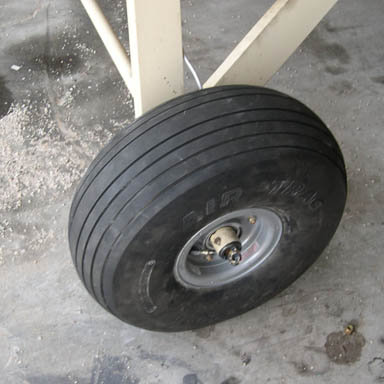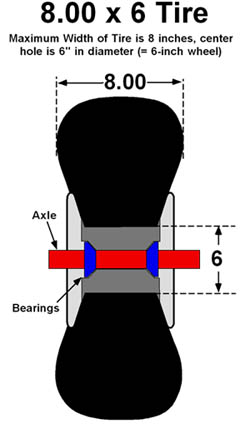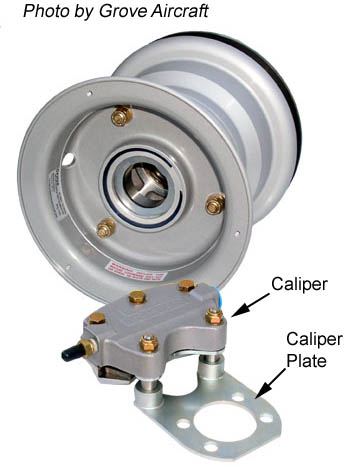What Size Wheels?
August 2009

You're building your Fly Baby...or your Fly Baby needs new tires, or
even completely new wheels and brakes. What should you get?
 Nomenclature
Nomenclature
First off, let's look at some tire nomenclature.
Aircraft wheel sizes are defined by diameter... basically, the diameter
of the rim where the tire installed. It's the size of the opening
on the middle of the tire. Typical sizes are four inch (used on
the J-3 Cub), five inch (used on light planes like the Cessna 150), and
six inch (used on most GA four-seaters), eight inch, ten-and-a-half
inches, etc..
The first number ("8.00") is what's called the nominal section width. This
is basically the cross-sectional width of the tire at its fattest point.
So an "8.00 x 6" tire is designed to fit on a six-inch wheel, and will
have a maximum width of eight inches.
The strange thing to me is that there isn't a designator for the overall diameter of the tire for
General Aviation tires! For all we know, one manufacturer could
build a tall, skinny tire, and another make a stubby small tire, and
both some in under the "8.00 inch nominal section width"
designator. This is an offshot of the use of "Type Three"
tires on light aircraft. Type Three tires are designed as
low-pressure tires for cushioning and floatation. Hence, the
specification for width to show how wide the footprint is (the wider
the footprint, the more rubber in contact with the ground, and the
lower ground pressure).
The aircraft world is about the last bastion of tubes, too....you don't
see tubeless tires on light aircraft. Probably the main
explanation is that small aircraft use two-part wheels...they split,
left and right halves, to allow you to mount tires with ordinary hand
tools. Go to the automobile tire shop and you'll see a pretty
hefty piece of machinery necessary to install and remove the tubeless
tires on a car rim. The split-rim design makes our lives much
easier, but the two halves would have to include an airtight seal if
tubeless tires are to be used. Hence, tubes are standard.
The "Stock" Choice
Pete designed the Fly Baby around the then-common Goodrich wheel and
tire used on the Piper J-3 Cub. Then
is the operatative word, here. These wheels haven't been made for
seventy years, and the Cub folks are getting mighty possessive of the
ones out there. Parts are scarce and expensive, and the tires and
tubes are cost about twice that of equivalent-sized tires.
Some folks still try to go with the Cub wheels. I really
recommend against it...you'll get as good of performance at a lot lower
cost with a standard 6-inch wheel.
One problem, though, is that Pete specifies a 1.25" diameter tube for
the axle in the plans. This is right for Cub wheels, but the
standard axle for modern 6" wheels is 1.5". So use the larger
tube for the axle when you build.

If you're looking for replacement wheels on a plane with the standard
Cub setup, you're in luck... several companies sell conversion kits to
allow the use of modern wheels on that 1.25" axle. Five inch
aircraft wheels do install on a 1.25" axle, but the options for tires
is pretty small...see the next couple of section.
Starting from Scratch
If you're building, you basically have your choice of using standard
5-inch or 6-inch wheels. Five-inch wheels are pretty
attractive from the price point of view, but the problem is, there
aren't a lot of options as far as tires. 5.00x5 is about all
that's there, and it's really too small for a Fly Baby. Go with a
six-inch wheel.
Brake assemblies aren't generally interchangable, so if you're buying a
given type of wheel, you'll need the brake assemblies to go with
them. In other words, get the whole set. I bought Grove
61-1 wheels/brakes and they seem to be working fine.
Picking A Tire Size
Hang on, folks...now we're getting into religion.
Pete picked the Goodrich Cub wheel and tire because it was designed for
a lot of cushioning...the inside diameter is small, and there's a LOT
of inflated tire out there. Remember, there is no shock absorbing
on a Fly Baby landing gear other than the tires and tubes! A
8.00x6 aircraft tire has about the same outside diamteter as the old
Cub tires...and since the Cub tires fit on a smaller wheel, the Cub
tire still gives you
more cushioning.
 However...cosmetics raises its ugly head.
Personally, I think the big-tire look is part of the charm of the Fly
Baby.
However...cosmetics raises its ugly head.
Personally, I think the big-tire look is part of the charm of the Fly
Baby.
Others differ. They think the big tires are ugly. And, if
they want to install wheel pants, the bigger tires makes the problem
tougher. They've installed 7.00x6, or even 6.00x6, tires on their
Fly Babies.
Since the folks who are doing this are generally experienced Fly Baby
pilots, there probably isn't much harm. Sure, I still botch
landings, but I rarely make the huge bone-slamming arrivals that I did
in the earlier days.
Rarely.
Anyway, the smaller tires are probably OK once you get some stick time
and get a feel for the beast. My Fly Baby had 7.00x6 tires
when I bought it, and I thought they did an acceptable job. When
it came time to replace, I went to 8.00x6s because I like a bit more
margin, and, like I said, I think they look better. I could have
gone 8.50x6 for even bigger tires...but the cost was about 50% higher,
and I doubt it would have been worth it.
 Return to the Tech
Page
Return to the Tech
Page


 Nomenclature
Nomenclature
 However...cosmetics raises its ugly head.
Personally, I think the big-tire look is part of the charm of the Fly
Baby.
However...cosmetics raises its ugly head.
Personally, I think the big-tire look is part of the charm of the Fly
Baby.  Return to the Tech
Page
Return to the Tech
Page